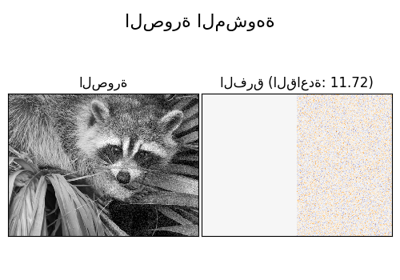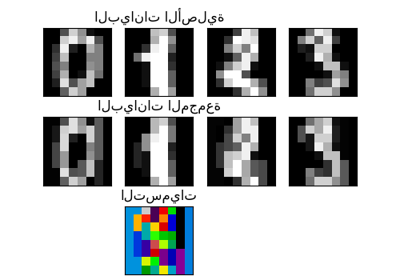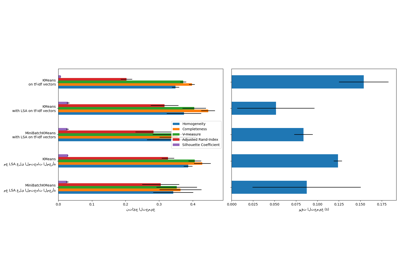ملاحظة
Go to the end to download the full example code. or to run this example in your browser via JupyterLite or Binder
تعلم القاموس عبر الإنترنت لأجزاء الوجوه#
يستخدم هذا المثال مجموعة كبيرة من الوجوه لتعلم مجموعة من الصور مقاس 20x20 التي تشكل الوجوه.
من وجهة نظر البرمجة، إنه مثير للاهتمام لأنه يظهر كيفية استخدام واجهة برمجة التطبيقات عبر الإنترنت لـ scikit-learn لمعالجة مجموعة كبيرة جدًا من البيانات على شكل أجزاء. الطريقة التي نتبعها هي أننا نحمل صورة في كل مرة ونستخرج عشوائيًا 50 رقعة من هذه الصورة. بمجرد أن نكون قد جمعنا 500 من هذه الرقع (باستخدام 10 صور)، فإننا نستخدم طريقة
partial_fit
للكائن KMeans عبر الإنترنت، MiniBatchKMeans.
يسمح الإعداد المفصل على MiniBatchKMeans برؤية أنه يتم إعادة تعيين بعض المجموعات أثناء المكالمات المتتالية لـ partial-fit. هذا لأن عدد الرقع التي تمثلها أصبح منخفضًا للغاية، ومن الأفضل اختيار مجموعة جديدة عشوائية.
# المؤلفون: مطوري scikit-learn
# معرف SPDX-License: BSD-3-Clause
تحميل البيانات#
from sklearn import datasets
faces = datasets.fetch_olivetti_faces()
downloading Olivetti faces from https://ndownloader.figshare.com/files/5976027 to /root/scikit_learn_data
تعلم قاموس الصور#
import time
import numpy as np
from sklearn.cluster import MiniBatchKMeans
from sklearn.feature_extraction.image import extract_patches_2d
print("Learning the dictionary... ")
rng = np.random.RandomState(0)
kmeans = MiniBatchKMeans(n_clusters=81, random_state=rng, verbose=True, n_init=3)
patch_size = (20, 20)
buffer = []
t0 = time.time()
# جزء التعلم عبر الإنترنت: دورة عبر مجموعة البيانات الكاملة 6 مرات
index = 0
for _ in range(6):
for img in faces.images:
data = extract_patches_2d(img, patch_size, max_patches=50, random_state=rng)
data = np.reshape(data, (len(data), -1))
buffer.append(data)
index += 1
if index % 10 == 0:
data = np.concatenate(buffer, axis=0)
data -= np.mean(data, axis=0)
data /= np.std(data, axis=0)
kmeans.partial_fit(data)
buffer = []
if index % 100 == 0:
print("Partial fit of %4i out of %i" % (index, 6 * len(faces.images)))
dt = time.time() - t0
print("done in %.2fs." % dt)
Learning the dictionary...
[MiniBatchKMeans] Reassigning 8 cluster centers.
[MiniBatchKMeans] Reassigning 5 cluster centers.
Partial fit of 100 out of 2400
[MiniBatchKMeans] Reassigning 3 cluster centers.
Partial fit of 200 out of 2400
[MiniBatchKMeans] Reassigning 1 cluster centers.
Partial fit of 300 out of 2400
[MiniBatchKMeans] Reassigning 3 cluster centers.
Partial fit of 400 out of 2400
Partial fit of 500 out of 2400
Partial fit of 600 out of 2400
Partial fit of 700 out of 2400
Partial fit of 800 out of 2400
Partial fit of 900 out of 2400
Partial fit of 1000 out of 2400
Partial fit of 1100 out of 2400
Partial fit of 1200 out of 2400
Partial fit of 1300 out of 2400
Partial fit of 1400 out of 2400
Partial fit of 1500 out of 2400
Partial fit of 1600 out of 2400
Partial fit of 1700 out of 2400
Partial fit of 1800 out of 2400
Partial fit of 1900 out of 2400
Partial fit of 2000 out of 2400
Partial fit of 2100 out of 2400
Partial fit of 2200 out of 2400
Partial fit of 2300 out of 2400
Partial fit of 2400 out of 2400
done in 1.62s.
رسم النتائج#
import matplotlib.pyplot as plt
plt.figure(figsize=(4.2, 4))
for i, patch in enumerate(kmeans.cluster_centers_):
plt.subplot(9, 9, i + 1)
plt.imshow(patch.reshape(patch_size), cmap=plt.cm.gray, interpolation="nearest")
plt.xticks(())
plt.yticks(())
plt.suptitle(
"Patches of faces\nTrain time %.1fs on %d patches" % (dt, 8 * len(faces.images)),
fontsize=16,
)
plt.subplots_adjust(0.08, 0.02, 0.92, 0.85, 0.08, 0.23)
plt.show()
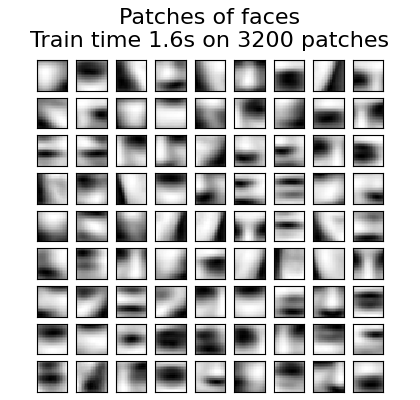
Total running time of the script: (0 minutes 3.866 seconds)
Related examples
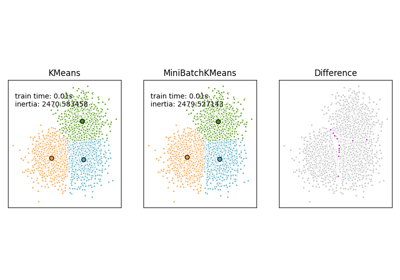
مقارنة خوارزميات التجميع K-Means و MiniBatchKMeans

